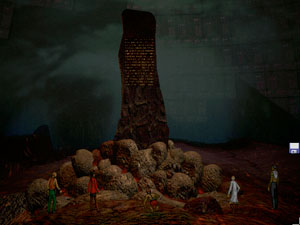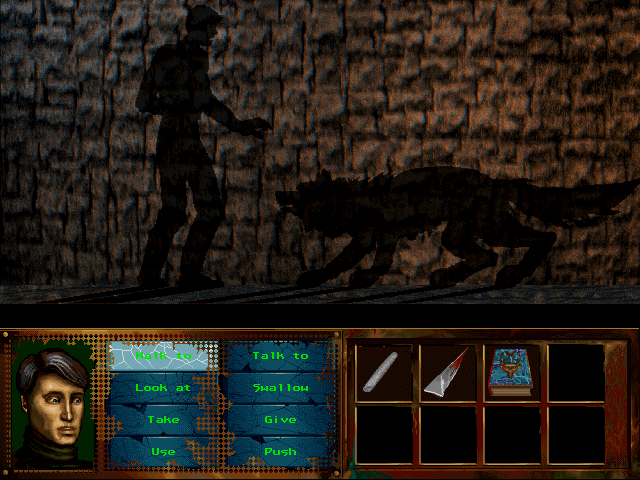Halloween is approaching. Everyone is getting out their costumes, setting up the
spooky decorations and watching classic horror movies. It’s also the time some gamers take to play
their favorite scary games, as well as October-themed specials going on for
games like Killing Floor and Team Fortress 2.
But for a lot of us, the scares are what we’re looking
for. Now’s the time to play the classics
like Eternal Darkness, Resident Evil, Silent Hill 2, System Shock 2 or Amnesia.
This year I have a recommendation on another horror
game. I’ve already gone over how Clock Tower is the scariest game ever made, but this
year I’m taking a moment to appreciate the aspects of a classic horror game
that don’t contribute to the horror.
I’ve always held a soft spot for 90s adventure games. I was quite a fan of King’s Quest 5 back in
the day, and even now with all the advancements companies like Telltale Games
have made to the genre, I can still play some of the adventure games from the
days of lesser graphics and game design.
I still love The Curse of Monkey Island, the Phantasmagoria games, and
The Neverhood as much as I ever have.
Sure they had annoying puzzles and huge leaps in logic when it came to
progressing through them, but the stories were so well told and presented, I
couldn’t help forgiving them.
That’s why when the opportunity came knocking, I bought the PC game adaptation of the short story I Have No Mouth and I Must Scream by Harlan Ellison. I had heard about the game being scary,
unsettling and overall pretty good, so when it was on sale for Halloween on
Steam earlier last year, I gave it a try myself.
Naturally, I enjoyed the traits many of the best 90s
adventure games sported: detailed artwork, a good story, and (mostly) good
voice acting to boot. Unlike some of the
other 90s adventure games though, I was also impressed with IHNMAIMS’s overall
design as a game because it managed to largely avoid the pitfalls many
other adventure games of the time are infamous for.
As I stated, many adventure games in the 90s had design quirks,
for lack of a better term. Anyone who
has played them knows the complaints as well as the jokes made about them: an increasing
load of inventory items, illogical solutions with only one way to do them you
likely had to find out through guesswork and not to mention some (usually from
Sierra) that killed you or rendered the game unwinnable without fair warning.
IHNMAIMS averts the overstocked inventory problem right off
the bat through its premise. The story
is about the last 5 humans on earth being tortured by a human-hating godlike
supercomputer named AM (Allied Mastercomputer), voiced by Ellison himself. AM makes each human play a game of his own
making, each one preying on their weaknesses.
That means every character, along with their scenario, has their own
inventory and map.
Each scenario’s landscape is relatively small (about half
the size of a suburban elementary school), making them easy to navigate and greatly
reducing backtracking. It’s much like Telltale
Games’ episodic adventure games released today in how it takes the story one
chapter at a time. Not only does this
mean you don’t have to go to hell and back if you forgot something, but because
there’s less to cover, should you decide to take the desperate practice of
trying to use everything you have on everything else to get something to happen,
it’s a lot quicker.
But in my playthrough of the game, that didn’t happen. With the exception of a few points of
guesswork and vagueness, IHNMAIMS is relatively logical in its solutions, and
when the rules of logic are bent in
AM’s twisted game, clues are given.
Without spoiling the solution, I cite a point in Ellen’s
scenario. In it, she must grab a chalice
from a room being guarded by a vicious sphinx that scares her away when she
comes in. However, if the player looks at
the room through a security monitor in another room, it doesn’t show the
sphinx. Hmmmmmm…
 |
| She doesn't even touch the thing! |
That, however, should not happen, and the game won’t kill
you for one slip-up. While it is possible to die, there are very few instances
it can happen, giving the game the relaxed play of Monkey Island, but with some
of the sense of peril of King’s Quest, where everything is trying to kill
you. In any situation in which you can
die, you can see it coming and it’s avoidable.
For example, in Ted’s scenario, he can hear the sounds of
wolves getting closer every time he enters the central room of the castle, and
the front door is missing a hinge. It
gives you several chances to figure out a way to shut the door, so if they bust
in and you die, it’s your own fault.
Other times the game doesn’t need to warn you and has you
rely on your common sense. If you cut
the airbags in a blimp in order to lower it to the height it needs to be at,
common sense tells you that you shouldn’t cut any more than that, or else…
In the same scenario, the designers anticipated a player’s
thought process in a specific way.
Instead of cutting the air bags, you can instead try to shoot a hole in
it with what is described as a bulky, single-shot handgun. However, you’re supposed to realize that the
reason it’s bulky and has one shot is because it’s a flare gun.
Fire does not go well with blimps.
Instead of simply giving a generic “I can’t use these two things together” line, the game knows what you were thinking, and you thought
wrong.
In one last brilliant design decision, each scenario has
multiple endings that give the game flexibility. These endings are determined by the
character’s moral actions through their chapter, long before games like
Infamous and Mass Effect implemented their own morality measurements. For example, having Ted be unfaithful lowers
his morality, and having Nimdok use ether to ease the pain of someone suffering
raises his.
There are different ways for the successful endings to play
out as well; there isn’t only one proper set of solutions. Although the alternate solutions never diverge
far from what you’re supposed to do, they allow for some tangential thinking.
For example, in Ted’s scenario, you’re told that there’s a
clue on the servant woman’s tapestry in her room. There are two ways in: you can either sleep
with her (lowering morality) or give the demon you summon that can open locks a
bit of energy to have him open the simple lock on her door. Alternate solutions like that also help give
the game some incentive to play through it again.
Unfortunately, much of the good about the game I just went
over sort of falls apart at the game’s finale, where the puzzles are abstract,
you’ll almost certainly need a guide, and you die permanently, but the 80% of
the game getting to that point is still a treat.
Before playing it, I thought I Have No Mouth and I Must
Scream was a cult classic because of its well-told story, like most
fondly-remembered adventure games, but having played it myself, I see there’s
more to it than that. While it shows its
age in some areas, IHNMAIMS holds up pretty well, even by today’s
standards. If you’re looking for a
creepy game to play this Halloween, or just a good adventure game in general, it’s a solid buy.







No comments:
Post a Comment